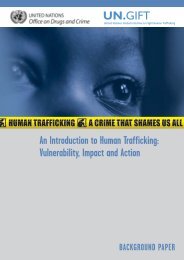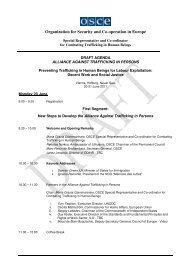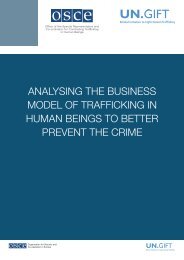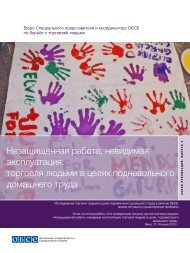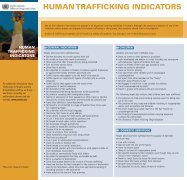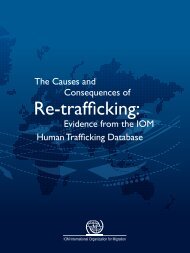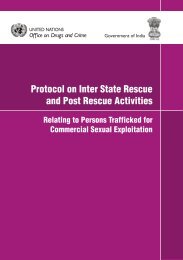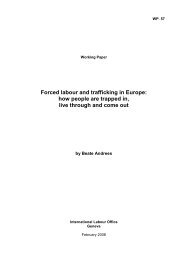Zastita zrtava i prevencija trgovine ljudima - UN.GIFT.HUB - UN ...
Zastita zrtava i prevencija trgovine ljudima - UN.GIFT.HUB - UN ...
Zastita zrtava i prevencija trgovine ljudima - UN.GIFT.HUB - UN ...
You also want an ePaper? Increase the reach of your titles
YUMPU automatically turns print PDFs into web optimized ePapers that Google loves.
ZAŠTITA ŽRTAVA I PREVENCIJA TRGOVINE LJUDIMA U SRBIJI<br />
PREVENTION OF HUMAN TRAFFICKING<br />
Here we propose a set of measures of primary, secondary and tertiary prevention<br />
that should be included into existing programmes as activities so as to<br />
influence not only the consequences of human trafficking but the causes as<br />
well. These would certainly result in reducing the size of the problem of human<br />
trafficking and not just on alleviating the consequences:<br />
Poverty, lack of opportunities and of<br />
access to education, social and gender<br />
inequalities, unemployment and<br />
civil conflicts are among the main<br />
factors to be addressed in developmin<br />
a root-cause-centred-approach<br />
that needs to add to the victim-centred<br />
and law enforcement-centred<br />
approaches.<br />
2009 October Declaration on Trafficking<br />
in Human Beings<br />
• Conduct future surveys in the field<br />
(instead of empyrical only) among<br />
vulnerable social groups (refugees<br />
and internally displaced persons in<br />
collective centres, Roma communities,<br />
asylum seekers, children in social<br />
protection institutions, children living<br />
and working in the street, women victims<br />
of violence...). In addition to data<br />
collection and better understanding<br />
of the factors of risk, these surveys<br />
would contribute to raising awareness<br />
of the community about the phenomenon of human trafficking and the<br />
related phenomena, particularly about child abuse and neglect, domestic violence<br />
and their consequences;<br />
• Examine the phenomenon of human trafficking from the aspect of<br />
social inclusion and poverty reduction policies; include it into development of<br />
these and the policies related to human rights, migrations, social protection,<br />
labour, gender sensitive and anti-discrimination and specifically — supression<br />
of violence; as well as in the implementation of policies through all the systems;<br />
and finally – monitoring of implementation;<br />
• With reference to the above, work on sensitization of professionals in<br />
all the systems dealing with marginalised groups in order to dispel prejudices<br />
and discrimination that are among the root causes of vulnerability;<br />
• Conduct limited, specialised programmes/campaigns promoting alternatives<br />
(models of social inclusion) and targeting vulnerable groups;<br />
• With reference to the above — develop and implement innovative,<br />
interactive and participatory programmes (e.g. forum theatre);<br />
• Undertake field visits (outreach activities) to support potential victims;<br />
• Enhance the capacity of the representatives of the above vulnerable<br />
groups (target groups, in this case) to implement preventive measures (peer<br />
education);<br />
• Implement programmes for groups — perpetrators of violence, especially<br />
the clients of services of victims (including specialised campaigns).<br />
And more concretely:<br />
• Since the survey shows the absolute majority of victims of trafficking<br />
to have an incomplete primary eduation, insist on implementation of the<br />
current mechanisms for prevention of drop-out from the mandatory primary<br />
education, and introduce new ones;<br />
• An additional feature among the vulnerability factors was noted in<br />
172



